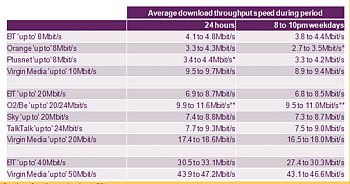There was a lot of talk this morning about Ofcom ‘s research announcement that
“Average download speeds remain less than half of ‘up to’ speeds advertised by some Internet Service Providers (ISPs), particularly for broadband delivered via a phone line. “
Ofcom is recommending that if speeds are used in broadband advertising they should be based on a Typical Speeds Range (TSR), so consumers have a clearer idea of what speeds to expect.
The stock response from ISPs is that every line is different and by announcing an “up to “ speed they cover all the bases and customers are appraised of the actual expected speed of their line before they sign up.
This is an interesting one. I work for an ISP but I am also a consumer. I see no reason why ISPs should not be able to give greater prominence to typical speeds rather than the “best you can possible expect”. We should being straight and honest with our customers – not hyping things up and raising expectations that can’t be met (you can tell I’m not a marketing person here 🙂 ).
ISPS have made some concession to the fact that if a technology (eg ADSL2+) can theoretically do 24Mbps most people are not going to get that speed. A 24Meg line is therefore often described as an “up to 20Meg” line (not universally as the Ofcom data in the table inset shows). My “up to 20Meg line only does 11Meg. It is disappointing but I understand the game. Not everybody does, though you do wonder whether most people care.
Most people do care about the quality of their experience though and in the absence of any other suitable metric typical speeds are a good enough representation of this.
The survey results do make interesting reading. Firstly the Virgin results which are based on cable modem technology and not ADSL are consistently better – their typical numbers are consistently close to the “up to” numbers. That’s a technology thing.
If you look at the ADSL providers with similar technologies I’m not sure that there is much to differentiate them. The thing that is holding back these ISPs from quoting typical speeds is that these speeds would be significantly slower than those of Virgin. Not good for a marketing director’s pulse.
I sympathize with these ISPs but at the end of the day my consumer head still thinks it would be right to quote the typical speeds and not the “up to”. Or at least both sets of numbers.
I can’t see this happening voluntarily. It would only take one ISP to break ranks for all the others to have to follow.
All I can say is bring on Fibre ToThe Premises where 100Meg will be 100Meg, give or take a wavelength. I really hope that my home town of Lincoln skips Fibre to the Cabinet and goes straight to FTTP.
